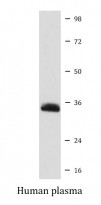ARG58196
anti-alpha 1 microglobulin antibody
anti-alpha 1 microglobulin antibody for IHC-Formalin-fixed paraffin-embedded sections,Western blot and Human
Overview
| Product Description | Rabbit Polyclonal antibody recognizes alpha 1 microglobulin |
|---|---|
| Tested Reactivity | Hu |
| Tested Application | IHC-P, WB |
| Host | Rabbit |
| Clonality | Polyclonal |
| Isotype | IgG |
| Target Name | alpha 1 microglobulin |
| Antigen Species | Human |
| Immunogen | Synthetic peptide derived from Human alpha 1 microglobulin. |
| Conjugation | Un-conjugated |
| Alternate Names | Bikunin; HCP; ITIL; ITILC; ITI; ITI-LC; UTI; Protein HC; Complex-forming glycoprotein heterogeneous in charge; EDC1; HI30; HI-30; Alpha-1 microglycoprotein; A1M; IATIL; Uronic-acid-rich protein; Protein AMBP |
Application Instructions
| Application Suggestion |
|
||||||
|---|---|---|---|---|---|---|---|
| Application Note | * The dilutions indicate recommended starting dilutions and the optimal dilutions or concentrations should be determined by the scientist. | ||||||
| Positive Control | Human plasma | ||||||
| Observed Size | ~ 35 kDa |
Properties
| Form | Liquid |
|---|---|
| Purification | Affinity purified. |
| Buffer | PBS (pH 7.4), 0.02% Sodium azide and 50% Glycerol. |
| Preservative | 0.02% Sodium azide |
| Stabilizer | 50% Glycerol |
| Storage Instruction | For continuous use, store undiluted antibody at 2-8°C for up to a week. For long-term storage, aliquot and store at -20°C. Storage in frost free freezers is not recommended. Avoid repeated freeze/thaw cycles. Suggest spin the vial prior to opening. The antibody solution should be gently mixed before use. |
| Note | For laboratory research only, not for drug, diagnostic or other use. |
Bioinformation
| Database Links | |
|---|---|
| Gene Symbol | AMBP |
| Gene Full Name | alpha-1-microglobulin/bikunin precursor |
| Background | This gene encodes a complex glycoprotein secreted in plasma. The precursor is proteolytically processed into distinct functioning proteins: alpha-1-microglobulin, which belongs to the superfamily of lipocalin transport proteins and may play a role in the regulation of inflammatory processes, and bikunin, which is a urinary trypsin inhibitor belonging to the superfamily of Kunitz-type protease inhibitors and plays an important role in many physiological and pathological processes. This gene is located on chromosome 9 in a cluster of lipocalin genes. [provided by RefSeq, Jul 2008] |
| Function | Inter-alpha-trypsin inhibitor inhibits trypsin, plasmin, and lysosomal granulocytic elastase. Inhibits calcium oxalate crystallization. Trypstatin is a trypsin inhibitor. [UniProt] |
| Cellular Localization | Secreted. [UniProt] |
| Calculated MW | 39 kDa |
| PTM | The precursor is proteolytically processed into separately functioning proteins. 3-hydroxykynurenine, an oxidized tryptophan metabolite that is common in biological fluids, reacts with Cys-53, Lys-111, Lys-137, and Lys-149 to form heterogeneous polycyclic chromophores including hydroxanthommatin. The reaction by alpha-1-microglobulin is autocatalytic; the human protein forms chromophore even when expressed in insect and bacterial cells. The chromophore can react with accessible cysteines forming non-reducible thioether cross-links with other molecules of alpha-1-microglobulin or with other proteins such as Ig alpha-1 chain C region 'Cys-352'. Heavy chains are interlinked with bikunin via a chondroitin 4-sulfate bridge to the their C-terminal aspartate. N- and O-glycosylated. N-glycan heterogeneity at Asn-115: Hex5HexNAc4 (major), Hex6HexNAc5 (minor) and dHex1Hex6HexNAc5 (minor). N-glycan at Asn-250: Hex5HexNAc4. O-linkage of the glycosaminoglycan, chondroitin sulfate, at Ser-215 allows cross-linking between the three polypeptide chains. [UniProt] |
Images (1) Click the Picture to Zoom In






